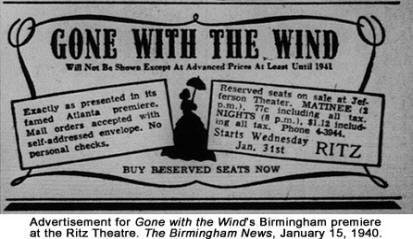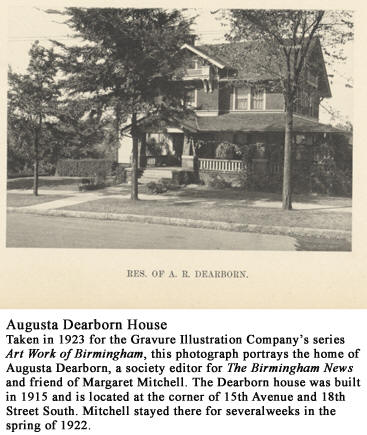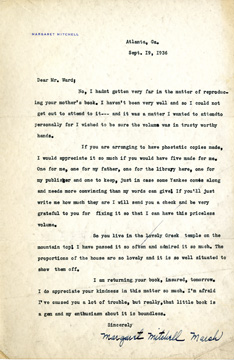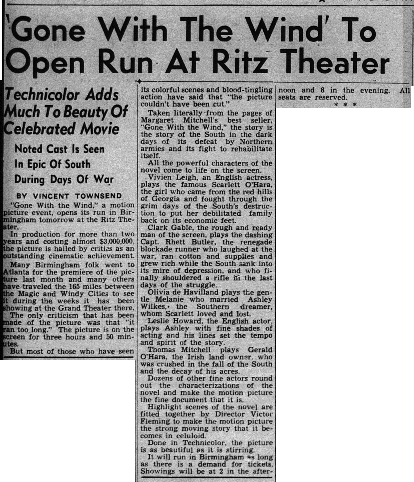|
By Andrew L. Nelson
Introduction

On January 31, 1940, six weeks after its famed Atlanta premiere, David O. Selznik’s
Gone with the Wind opened to Birmingham audiences at the
Ritz Theatre on 2nd Avenue North. Adapted from Margaret Mitchell’s 1936 novel,
Gone with the Wind tells the tale of Scarlett O’Hara, the spoiled yet determined daughter of a Georgia plantation owner, and along the way depicts the Civil War and Reconstruction southern society inhabited by O’Hara and the film’s multitude of characters.

Seventy-five years after its release, Gone with the Wind remains a cinematic marvel. It was one of the first films shot using Technicolor cameras, and its sets and scenery, the emotional pull of its music, and epic scenes like the burning of Atlanta make the film a groundbreaking technical achievement. Its story is equally memorable, as the film is populated by characters and dialogue that have become mainstays in American popular culture. At the 1940 Oscars,
Gone with the Wind was rewarded for these achievements, becoming the first color film to win Best Picture and receiving seven additional academy awards.
Gone with the Wind also carries with it a complex and troubled historical legacy, for it has always been more than a movie; it is an influential cultural text that crafted lasting narratives of region, race, and history. The documents in this digital collection reflect these aspects of
Gone with the Wind while highlighting a number of historical linkages between the film and the Magic City.
Margaret Mitchell herself lived in Birmingham for several weeks in the spring of 1922, staying at the home of her friend Augusta Dearborn, who was an assistant society editor with
The Birmingham News. In addition, in the late 1930s Mitchell carried on a lasting correspondence with former Birmingham mayor
George Ward.
 There are also rumors that some of Birmingham’s most notable late nineteenth-century residents were the inspiration for characters in
Gone with the Wind. It has been suggested, for example, that Birmingham’s famed madam
Lou Wooster was the model for
Gone with the Wind’s equally kind-hearted madam Belle Watling and that Mitchell patterned the character of Rhett Butler after Birmingham banker and industrialist
Charles Linn. Neither of these legends is true, but their persistence speaks to
Gone with the Wind’s most profound legacy—its impact on cultural memory.
Gone with the Wind influences how southern history is remembered so indelibly that in Birmingham and other southern cities local lore and historical figures are at times recounted in terms established by the film’s narrative and characters. There are also rumors that some of Birmingham’s most notable late nineteenth-century residents were the inspiration for characters in
Gone with the Wind. It has been suggested, for example, that Birmingham’s famed madam
Lou Wooster was the model for
Gone with the Wind’s equally kind-hearted madam Belle Watling and that Mitchell patterned the character of Rhett Butler after Birmingham banker and industrialist
Charles Linn. Neither of these legends is true, but their persistence speaks to
Gone with the Wind’s most profound legacy—its impact on cultural memory.
Gone with the Wind influences how southern history is remembered so indelibly that in Birmingham and other southern cities local lore and historical figures are at times recounted in terms established by the film’s narrative and characters.
As was the case throughout the nation, when Gone with the Wind first arrived in Birmingham in 1940, its retelling of antebellum southern history had significant bearing on contemporary local society.
Gone with the Wind represented the continued perpetuation of the “Lost Cause” ideology, a southern mythology that held that slavery was a benevolent and necessary system and that the South was forced into the Civil War in a noble defense of states’ rights rather than a staunch commitment to slavery.
Contemporary historians point out that in its idyllic re-imagining of the Old South and its portrayal of African Americans as simple, jolly slaves who are endlessly loyal to their charitable masters,
Gone with the Wind served as cinematic justification for segregation, disfranchisement, and other facets of southern Jim Crow society. For these reasons, upon its release
Gone with the Wind was met with demonstrations by African American groups across the nation and widespread criticism in the black press.
All of these facets of Gone with the Wind’s legacy are seen throughout the materials in this digital collection. In local newspaper articles and advertisements, the film’s illustrated program, and the correspondence between Margaret Mitchell and George Ward, one finds evidence of
Gone with the Wind’s groundbreaking cinematic accomplishments, widespread popularity, and the cultural
.jpg) work the movie undertook in romanticizing the southern past and bolstering Jim Crow. work the movie undertook in romanticizing the southern past and bolstering Jim Crow.
For those interested in further reading on Gone with the Wind’s lasting implications on southern history and memory, below are links to online articles as well as bibliographic information for books about
Gone with the Wind and related topics that can be found at the Birmingham Public Library.
Newspaper Articles
Coming primarily from The Birmingham News, these
newspaper articles exemplify the local press’s coverage of
Gone with the Wind’s 1939 Atlanta premiere and its January 31, 1940 premiere in the Magic City at the Ritz Theatre. Also included are newspaper advertisements that reflect
Gone with the Wind’s status as a full-fledged cultural phenomenon.
Margaret Mitchell and George Ward Correspondence
These
ten letters were written by Margaret Mitchell to George Ward between 1936 and 1939, the years between
Gone with the Wind’s publication as a novel and release as a film. In 1893, Ward’s mother Margaret Ketchum Ward testified for the U.S. Senate Committee Upon Relations between Labor and Capitol, sharing her memories of life in antebellum Georgia and in the process painting a romanticized yet historically distorted picture of the Old South that resonated with Mitchell’s depiction in
Gone with the Wind. Seeing similarities between his mother’s testimony and Mitchell’s novel, George Ward mailed a copy of Margaret Ketchum Ward’s testimony to Mitchell, who was thrilled to receive it and lavished it with praise. Margaret Ketchum Ward’s complete 1893 Senate testimony can be viewed in person at the Birmingham Public Library Archives
or
online via
Google Books.
Gone with the Wind Program
In 1939 and the early 1940s, this eighteen-page
illustrated program
was sold by theaters showing Gone with the Wind. The example here represents a second version of the program. The original included an illustration of Hattie McDaniel’s character Mammy in the group of portraits on the back cover, but McDaniel’s likeness was replaced with that Alicia Rhett’s character India Wilkes due to fears that southern audiences would not approve of the inclusion of an African American actress alongside the film’s white performers.
 References References
Books
Steve Daly, et. al.,
Gone with the Wind: The Great American Movie 75 Years Later.
James L. Baggett (editor),
A Woman of the Town: Louise Wooster, Birmingham’s Magdalen.
David W. Blight, Race and Reunion: the Civil War
in American Memory.
Bruce Chadwick,
The Reel Civil War: Mythmaking in American Film.
Online Articles
Mike Cidoni Lenno, “Gone with the Wind at 75: Masterpiece or Historical Mess?,”
The Kansas City Star, September 26, 2014.
E.R. Shipp, “Gone with the Wind and Its Pernicious Place in History,”
The Root, September 28, 2014.
|